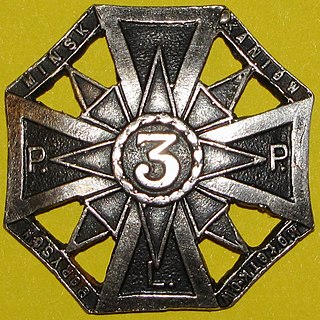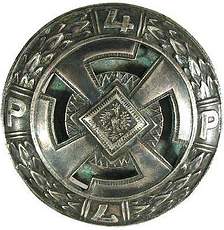Polish 6th Infantry Division was a unit of the Polish Army in the interbellum period, which fought in the Polish–Ukrainian War, Polish–Soviet War and Polish September Campaign. It was formed on May 9, 1919, in the area around Kraków, its first commandant was Colonel Ignacy Pick. Between 1919 and 1920, the unit fought Ukrainian troops in eastern part of former Galicia. Then, it participated in the Polish–Soviet War, halting the advance of the Soviet 1st Cavalry Army led by General Semyon Budyonny. Several soldiers were after the conflict awarded with various orders, including the Virtuti Militari. In 1921, when hostilities ended, the division returned to its bases – headquarters and most regiments were stationed in Kraków, some other regiments were garrisoned in Tarnów and Wadowice.
Polish 3rd Legions Infantry Division was a tactical unit of the Polish Army between the World Wars. Formed in 1919, as a third unit composed significantly of veterans of the Polish Legions in World War I, it saw extensive action during the Polish-Bolshevik War and the Invasion of Poland. In the interbellum period, the headquarters of the division was stationed in Zamość, while its regiments were garrisoned in Chelm, Lublin, Zamosc and other locations.
5th Lwów Infantry Division was a unit of the Polish Army in the interbellum period, with headquarters stationed in Lwów. It was created on May 20, 1919, during the Polish–Ukrainian War in Eastern Galicia. Originally, it consisted of three infantry regiments, but later it was strengthened with additional two. During Polish September Campaign it was commanded by General Juliusz Zulauf. The Division consisted in September 1939 of these regiments:

Polish 24th Infantry Division was a unit of the Polish Army in the interbellum period, which took part in the Polish September Campaign. The Division was created in 1921, and its first commandants were: General Jan Hempel, General Wacław Scaevola-Wieczorkiewicz, Colonel Boleslaw Maria Krzyzanowski, and Colonel Boleslaw Schwarzenberg-Czerny. The 24th Division's headquarters were located in Jarosław, with some regiments stationed in nearby cities of Rzeszów and Przemyśl. It consisted of:
The Battle of Boratycze took place on September 14, 1939, during the Invasion of Poland. Polish 24th Infantry Division, commanded by General Kazimierz Fabrycy, and supported by units of Border Protection Corps, clashed with German 2nd Mountain Division. The battle took place near the village of Boratycze, located between Przemysl and Lwów in the Second Polish Republic.

Stanisław Eugeniusz Skwarczyński (1888–1981) was a soldier of the Austro-Hungarian Army, officer of Polish Legions in World War I, and General brygady of the Polish Army. He fought in several conflicts, including World War I, Polish-Czechoslovak War, Polish-Ukrainian War, Polish-Soviet War and the Invasion of Poland. Furthermore, Skwarczynski was a freemason, member of a Masonic Lodge in Wilno.

The 9th Lesser Poland Uhlan Regiment was a cavalry regiment of the Polish Army, formed on November 21, 1918. Its first commandant was Rittmeister (Rotmistrz) Józef Dunin-Borkowski. The regiment fought in the Polish–Ukrainian War, Polish–Soviet War and the Invasion of Poland. In the Second Polish Republic, it was garrisoned in the towns of Czortków and Trembowla, and in 1939, it was part of Podolska Cavalry Brigade. The 9th Regiment was named after historic Polish province of Lesser Poland.

3rd Legions' Infantry Regiment was an infantry unit of Polish Legions in World War I, Polish Army and the Home Army. It existed in 1914–1939 and 1944–1945.

4th Niemen Uhlan Regiment was a cavalry unit of the Polish Army in the Second Polish Republic. It was garrisoned in the city of Vilnius, and it celebrated its day on 9 July, the anniversary of the 1920 Charge of Hrebionka.

11th Legions Infantry Regiment of Marshal Edward Śmigły-Rydz was a cavalry unit of the Polish Army, which existed in 1918–1939. It fought in the Polish–Soviet War and the Invasion of Poland. In the Second Polish Republic, the regiment was garrisoned in Ciechanów, and in 1939, belonged to Mazowiecka Cavalry Brigade.

14th Jazłowiec Uhlan Regiment was a cavalry unit of the Polish Army in the Second Polish Republic, also a unit of Polish Armed Forces in the West and the Home Army. During the interbellum, the regiment garrisoned Lwów. It was named after the village of Yazlovets (Jazłowiec), where on July 11–13, 1919, one of the battles of the Polish–Ukrainian War took place.
24th Uhlan Regiment of Crown Hetman Stanislaw Zolkiewski was a cavalry unit of the Polish Army in the Second Polish Republic. Formed in June 1920, it fought both in the Polish–Soviet War and the 1939 Invasion of Poland. The regiment was garrisoned in the town of Kraśnik, and belonged to the elite 10th Motorized Cavalry Brigade.

Fourth Legions Infantry Regiment (Poland) was an infantry regiment of the Polish Legions in World War I (1915–1917) and the Polish Army in 1918–1939. During the interbellum period, it was garrisoned in the city of Kielce, and was part of the 2nd Legions Infantry Division.
5th Legions Infantry Regiment of Józef Piłsudski was an infantry regiment of the Polish Army in 1918–1939. It was garrisoned in Vilnius as part of the 1st Legions Infantry Division.
6th Legions Infantry Regiment of Józef Piłsudski was an infantry regiment of the Polish Legions and the Polish Army. It existed from 1915 until 1939. Garrisoned in the city of Wilno, it was part of the 1st Legions Infantry Division.

8th Legions Infantry Regiment was an infantry regiment of the Polish Army. It existed from 1918 until 1939. Garrisoned in Lublin, and belonged to the 3rd Legions Infantry Division from Zamość. The regiment traced its traditions back to the 8th Infantry Regiment of the Duchy of Warsaw, commanded by Colonel Cyprian Godebski.
11th Infantry Regiment was an infantry regiment of the Polish Army. It existed from 1918 until 1939. Garrisoned in Tarnowskie Góry, the unit belonged to the 23rd Infantry Division from Tarnowskie Góry. Due to its location in Polish Upper Silesia, the regiment was called Upper Silesian.
14th Infantry Regiment of the Land of Kujawy was an infantry regiment of the Polish Army. It existed from 1918 until 1939. Garrisoned in Włocławek, the unit belonged to the 4th Infantry Division from Toruń.
15th Wolves Infantry Regiment was an infantry regiment of the Polish Army. It existed from January 1919 until September 1939. Garrisoned first in Bochnia and Ostrow Mazowiecka, and finally in Dęblin (1921–1939), the unit belonged to the 28th Infantry Division from Warsaw.
19th Relief of Lwów Infantry Regiment was an infantry regiment of the Polish Army. It existed from April 1919 until September 1939. Garrisoned in Lwów, the unit belonged to the 5th Lwów Infantry Division from Lwów. Its reserve battalion was stationed in Brzeżany. During the 1939 Invasion of Poland, the regiment, together with its division, belonged to Pomorze Army.